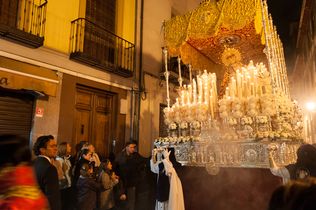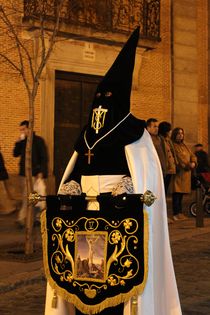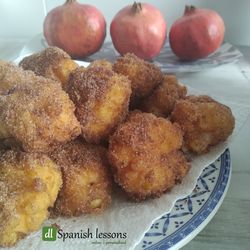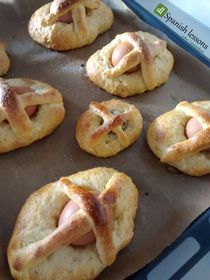PODCAST: read and listen to this entry at the same time (you can find the Spanish text here)
Easter week is one of the most important and popular festivities in my country. Easter week begins with the end of Lent, and during this time, Christians celebrate the Passion of Christ. This means that it has a religious origin. However, it also combines traditions, culture and gastronomy. Almost everyone celebrates Easter week, be it participating in the processions or the liturgies, or maintaining traditions that are somewhat more pagan.
When does it start, and when does it end?
Easter week starts right on Palm Sunday, a day where a procession takes place during which people carry palm branches. The date we celebrate Palm Sunday changes every year, but it always falls on March or April. Depending on the Spanish region, Easter vacations, where no one works and where there’s no school, begin the following Monday. However, the main holidays in all of Spain start on Holy Thursday and end on Easter Sunday.
We don’t celebrate Easter week the same way in all of Spain. There are differences between the regions in regard to traditions, gastronomy and types of processions. Still, generally, throughout Spain there are processions with “pasos”.
What are “pasos”?

They are religious figures that are mounted on a platform which are carried around the cities and towns in a procession. These “pasos” are carried by “costaleros” which are situated below a structure of wood or metal. Usually they can’t be seen because they are covered by drapes.
“Costaleros” are a group of people that train the whole year to be able to carry the “pasos” during the processions. In the picture, you can see a “paso” with a virgin statue. Furthermore, during the processions you can see “nazarenos” walk in front, followed by the “pasos”.
Who are the “nazarenos?

“Nazarenos” form part of a confraternity of lay brothers and they usually dress wearing a “capirote” (Catholic pointed hat), which covers their faces, as well as a tunic. They often carry candles to light the way. The tunic and the “capirote” are being used since the 16th and 17th century. On the right, you can see a “nazareno” with his typical costume.
Therefore, should you travel to Spain during Easter week, you’ll find in the streets processions with “nazarenos” lighting the way so the “costaleros” can promenade the “paso”. People will be standing clustered on the sides of the street or watching from the balconies. Depending on the procession, and the Spanish region you find yourself in, there can be differences on how the processions are experienced. People can be silent or, on the contrary, singing “saetas” from their balconies. All this can be seen either in broad daylight during the day or in the darkness of the evening/night.
Do you find it difficult to imagine what these processions with their music, traditional costumes, etc. are like?
Have a look at the promotional video of the Order of the Brotherhoods of Seville on the right.
Here you can see various processions around Seville during Easter week and you can listen to the typical music of these festivities as well. In the video, you can see pasos, nazarenos, costaleros and people enjoying the processions.
In addition, there are many performances of the Passion of Christ. You can see this in the second video, which shows the Easter week in Malaga.
Here you can also see processions that take place in Malaga during the day as well as during the night. However, the most interesting thing is that you can hear a saeta, which is a type of traditional chant for the festivities. Furthermore, you what the performances are like.
I’m sure that you noticed in the videos, that the prevalent colors of the processions are red, white, golden and purple.
These are the colors of Easter week and they have a specific meaning for each day. Besides, they are used for the liturgies.
Gastronomy during Easter week

Like in every important celebration, gastronomy plays a leading role and accompanies the celebration with salty and sweet dishes. There exist big differences between the various regions, and therefore I will tell you about dishes that are known throughout Spain. Subsequently, I will then tell you about things that are typical for my region, the Region of Valencia. What are some typical dishes? Well, there’s garlic soup which is a very traditional dish during those festivities, as well as codfish stew. At home, we always had a stew with chickpeas, spinach and codfish during Easter week. Most of the dishes are without meat because it should be avoided. Because of that, the oldest and most traditional dishes are without meat. And what’s for dessert? The most common thing to eat is French toast and Nun’s puffs. I already talked about Nun’s puffs in another blog entry. This is where you can also find the recipe. Here’s the link in case you would like to have another look at it.
Eggs are in Spain a symbol for Easter, too. In my region we have on Easter Sunday “la mona”.
What is la mona?

“Día de la Mona” is a special day where you go with family or friends to the countryside to spend the day. You eat together, and afterwards you eat the mona as an afternoon snack. The mona is a sweet type of crumpet with a hard-boiled egg at its center. Usually, it has a round or elongated shape. However, in Alicante it’s quite common that it has the shape of an animal, e.g. a lizard or a snake, with the egg in their mouth.
This egg plays an important role, especially for the children. Why? Well, on this day you are allowed to smash the egg on someone’s head or forehead. It’s fun, trying to catch someone so you can smash the egg on their head. Kids and not-so-kids have a great time.
It’s very traditional in Alicante and almost everyone’s favorite day of Easter week. We celebrate the mona on Easter Sunday.
Credits:
Featured image: dl Spanish lessons
Picture 1: “Semana Santa procession in Granada, Spain” by Anna & Michal is licensed under CC BY 2.0
Picture 2: “Avila, Semana Santa procession” by Arian Zwegers is licensed under CC BY 2.0
Picture 3: dl Spanish lessons
Picture 4: dl Spanish lessons
References:
Semana Santa en España: destinos para vivirla intensamente, Portal Oficial de Turismo de España.
Semana Santa, Wikipedia.
Colores litúrgicos, Wikipedia.
